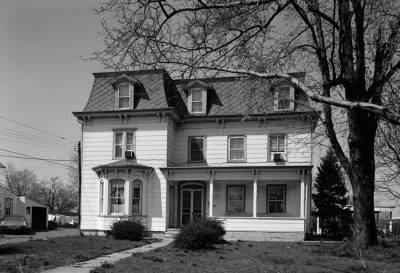
The Red Bank, N.J., home of T. Thomas Fortune, pivotal public intellectual and pioneering 19th century journalist, is in jeopardy.
Timothy Thomas Fortune, born a slave in Marianna, Fla., in 1856, was the legendary editor of the New York Age, the most influential Black newspaper in the early 20th century. Freed by the Emancipation Proclamation, he attended Howard University before making his way north. He became a confidant to the oft-at-odds Marcus J. Garvey, Booker T. Washington and W.E.B. DuBois, a testament to his foresight and persuasive powers.
The Victorian mansion in Monmouth County on Red Bank’s Westside is privately-owned, boarded up, off and on the market, and widely unrecognized for its significance. This is odd, when it was listed in 1976 as a National Historic Landmarks by the National Park Service, a high-level designation.
Black journalists understand the importance of history. Among renaissance men and women, pioneering journalists were the writers, poets, entrepreneurs, political activists and thinkers who shaped our progress. Ida B. Wells Barnett, Samuel Cornish and John Russwurm, Martin Delaney are just a few.
Gilda Rogers, journalist, entrepreneur and Red Bank preservationist, took up the Fortune House effort in 2007. She wrote about his commute by ferry to New York City, likely visits from civil rights giants of the day, meetings of the minds that went on there.
She has reached out to community groups, the state NAACP and members of the National Black Writers Conference. Now it seems the Westside Men’s Club with tax-exempt status is stepping up to work with the effort.
Articles were written, negotiations for purchase began and faltered, nothing caught fire. Preservation New Jersey, an advocacy group, named the house to its 10 most endangered sites.
“We need to shine a media spotlight on the situation, get a news outlet to view the house with a historian, we need writers to create an agenda for it,” said Rogers.
Fortune became editor of then purchased the newspaper, which eventually became The New York Age. He employed Ida B. Wells for a time. He became leader of the Afro-American Press Association, such a forward thinker to propose this terminology near the turn of the 19th century, reasoning we were African descendants in America. He also ghostwrote speeches and even books for Booker T. Washington and authored Black and White: Land, Labor and Politics in the South in 1884. In 1923, he became editor of the Negro World, replacing the imprisoned Marcus Garvey. He would die in 1928.
“Kids walk past the house every day and they have no clue. There is nothing memorializing T. Thomas Fortune,” said Rogers.
Historic preservation consultant Peter Primavera, who said he learned of the site in 1997, foresaw the possibility of demolition on a recent visit to Red Bank as the real estate market reheated and downtown development is being planned.
“I didn’t have to think about it. I went home and started sending emails and making phone calls and it’s all snowballed into this renewed effort,” he said.
“Can you imagine being born a slave in Florida and living in a beautiful Second Empire mansion in New Jersey?” Primavera asked. “It’s a remarkable American history story. I think what’s left of the house could be easily restored to a sufficient level so the story could be told in an incredibly effective way.”
NABJ founding member Claudia Polley’s historic preservation vita rivals her journalistic resume. A newscaster for NBC News in New York and National Public Radio, she helped the National Trust for Historic Preservation create the National Association for African American Heritage Preservation. She served on the African-American Landmarks Committee of Indiana and played a pivotal role in restoring the Madam C.J. Walker Theatre in Indianapolis. NABJ conducted a group tour at the 2005 national convention.
To her, the challenge is about telling the compelling stories.
“I would think there has to be a larger picture that has the T. Thomas Fortune story, personified by his house, as the center. You have to make the story resonate with everyone who reads it, and the best way to do that is to have them think of stories and people they know of that match or fit this tale. This kind of educated struggle was taking place across the country by men and women who dared to stand and speak,” she wrote in an email message.
Philadelphia journalist and Black broadcast pioneer Reginald Bryant is interred at Eden Cemetery, founded in 1902 by African Americans just outside the city. A marker was placed in April a few steps from graves of other famed “citizens of Eden” among them Jessie Redmon Fauset , poet and editor of The Crisis; William Still, father of the Underground Railroad; rights advocate Octavius Catto – and T. Thomas Fortune.
How the Fortune House will be used — as a museum, cultural or community center — is for the community to decide, according to the preservationists. But first, it has to be saved.
Find updates and “like” the campaign at Facebook.com/ThomasFortuneHouse.
Linda Shockley, a NABJ member since 1984, is president of the Lawnside (N.J.) Historical Society, Inc., owners of the Peter Mott House Underground Railroad Museum, listed on the National Register of Historic Places since 1994. She has served on New Jersey’s Sites Review Board and was secretary of Preservation New Jersey. She has worked for the Dow Jones News Fund, Inc., for the past 25 years.
